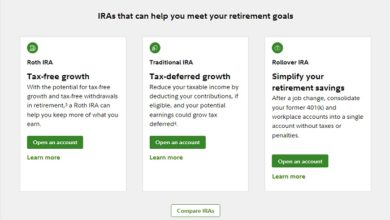
A Roth IRA is a type of individual retirement account (IRA) that you finance with money that has already been taxed. The investments within a Roth IRA have the potential to grow tax-free, and under specific conditions, withdrawals may also be tax-free. Contributions made to a Roth IRA can be withdrawn at any time without incurring penalties.
Benefits of a Roth IRA
Tax Savings
Retain a greater portion of your earnings: In a Roth account, any investment growth is tax-exempt, allowing for tax-free withdrawals during retirement.
Flexible Access to Your Funds
Require funds quickly? Any contributions you make to your Roth IRA can be withdrawn at any time, for any reason, without incurring taxes or penalties.
Earned Income
To qualify for contributions, you only need to have income within designated IRS thresholds.
Disadvantages of Roth IRA
No Immediate Tax Deduction
Contributions to a Roth IRA are made with after-tax dollars, meaning you don’t receive an immediate tax deduction as you would with a traditional IRA. This can be a drawback for individuals seeking immediate tax benefits.
Income Limits
High-income earners may not be eligible to contribute to a Roth IRA directly due to IRS income limits. However, there are strategies such as the “backdoor Roth IRA” that can bypass these limits.
Potential Legislative Changes
Future changes in tax laws or regulations could impact the tax benefits of Roth IRAs. While unlikely, it’s essential to consider the potential for legislative changes when planning your retirement savings strategy.
Investment Restrictions
Roth IRAs have limitations on certain types of investments, such as real estate and certain derivatives. This may restrict investment options for individuals seeking a more diversified portfolio.
Opportunity Cost of Paying Taxes Upfront
By paying taxes upfront on Roth IRA contributions, individuals miss out on potential investment growth from the tax deduction they would receive with a traditional IRA. This can be a consideration for individuals in lower tax brackets or expecting their tax rate to decrease in retirement.
FAQs on Roth IRA
How Much Can I Contribute to My IRA?
For 2023, you can contribute up to the lower of 100% of your earned income or $6,500. In 2024, this limit increases to the lower of 100% of your earned income or $7,000. Additionally, once you reach age 50, IRA contribution limits increase by an additional $1,000, allowing for a “catch-up” contribution for individuals nearing retirement.
If I qualify to contribute to both a traditional IRA and a Roth IRA, are there tax implications I should consider?
If you’re eligible to contribute to both a traditional IRA and a Roth IRA, it’s essential to consider potential tax implications. Maintaining a mix of pre-tax and Roth contributions can offer added flexibility in retirement, especially given the uncertainty surrounding future tax rates. For individuals anticipating retirement income to match or exceed their current earnings, or those expecting higher tax rates in retirement, prioritizing Roth IRA contributions may be advantageous. Conversely, if you anticipate lower tax rates in retirement compared to your current tax bracket, prioritizing pre-tax vehicles like the traditional IRA may be more beneficial. To determine the best approach for your situation, consider using our IRA Contribution Calculator, which allows you to input specific details and receive personalized recommendations.
Should I Consider Owning a Roth IRA?
In most cases, it’s advisable for investors to include a Roth IRA in their retirement strategy. This is because a Roth IRA provides the opportunity for federal tax-free growth and withdrawals, which can help reduce taxes and enhance retirement savings. However, it’s important to note that contributing to a Roth IRA is subject to certain income requirements.
How Is a Roth IRA Different from a Traditional IRA?
A Roth IRA involves contributing money that has already been taxed, meaning it’s funded with “after-tax” dollars. Any earnings within a Roth IRA have the potential to grow tax-free as long as they remain in the account. Withdrawals of earnings from Roth IRAs are both federal income tax-free and penalty-free, provided a 5-year aging period has been met and the account owner is age 59½ or over, disabled, or deceased. Additionally, Roth IRAs are not subject to required minimum distribution (RMD) rules during the original owner’s lifetime, allowing assets to continue growing in the account.
On the other hand, with a traditional IRA, contributions can be made on an after-tax basis or a pre-tax (tax-deductible) basis, depending on specific requirements. Earnings within a traditional IRA are tax-deferred as long as they remain in the account. However, withdrawals of pre-tax funds are subject to ordinary income tax upon withdrawal. RMDs are required from traditional IRAs no later than April 1 of the year following the year in which the account owner turns age 73½.
Both types of IRAs may incur ordinary income taxes and a 10% early withdrawal penalty on distributions taken before age 59½. However, with a Roth IRA, contributions can be withdrawn at any time, for any reason, without taxes or penalties.
Which Tax Form Will I Receive for My Roth IRA Contributions?
If you’ve made contributions or rolled funds into a Roth IRA, expect to receive Form 5498 from Fidelity in January. This form provides a summary of your IRA contributions, rollovers, holdings, and fair market value. If you make a contribution for the previous tax year between January and the tax filing deadline, you’ll receive a revised Form 5498 in May. It’s important to note that this form is for informational purposes only and does not need to be filed with your taxes. For assistance with this tax form, refer to the IRS Instructions for Form 5498 (PDF).
Which Tax Form Will I Receive for My IRA Withdrawals?
If you’ve made withdrawals (of $10 or more) from an IRA, you’ll receive Form 1099-R from Fidelity in January. This form provides details about your IRA withdrawals. For additional information on Form 1099-R and how to report withdrawals on your tax return, consult the IRS Instructions for Form 1099-R (PDF).
Source: https://www.fidelity.com/retirement-ira/roth-ira









DISCLAIMER: The information provided on InvestmentTotal.com is for general informational purposes only. The content on this website is not intended to be, and should not be construed as, professional financial advice.